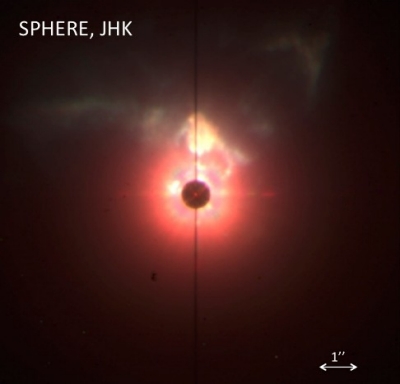SPHERE Science Verification (SV) took place from 4 to 11 December 2014 on VLT UT3. Out of 67 submitted proposals, 40 programmes were scheduled for a total of 88.4 hours of observations. Nineteen programmes were completed, with an additional 9 programmes receiving partial data sets. Some more SV time is planned in February 2015 and it is hoped to undertake some of the remaining 12 observing programmes.
SPHERE Science Verification

Muiti-colour, JHK coronographic image of the nebula around the red hypergiant star VY CMa observed with SPHERE IRDIS during SV. [Credit: R. Siebenmorgen / ESO]
SPHERE worked very well and produced spectacular data. Unprecedented angular resolution could be achieved, e.g., resolving the stellar surface of a star with a diameter of about 55 milliarcseconds or binary stars with separations on similar angular scales. The coronagraphic mode delivered contrast ratios of up to 106 at subarcsecond angular resolution.
A wide range of science topics was covered by the SV observations. They included imaging and spectroscopy of Solar System objects (satellites of asteroids, shapes of asteroids, Jupiter's moons), exo-planetary systems, proto-planetary and debris discs around young stars, the mass loss and environment of evolved stars, the circumstellar ring of SN 1987A and the inner region of the active galactic nucleus of NGC 1068. All raw data are publicly available from the ESO Science Archive or through the SPHERE SV webpage.

The image shows a SPHERE ZIMPOL, V-band diffraction-limited image, at the full VLT resolution (λ/D) of 15 milli-arcseconds, of the red hypergiant star VY CMa. [Credit: R. Siebenmorgen / ESO]
